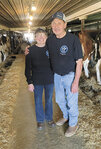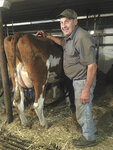MEADOWLANDS, Minn. – Although dairy farms are few and far between in northeastern Minnesota, Anthony and Lyn Kozumplik are managing to keep their dairy business alive through the challenges they face.
The Kozumpliks milk about 60 cows, mostly Holsteins with a few crossbreds, in a tiestall barn. Their 520-acre farm is 3.5 miles from Meadowlands and midway between Duluth and Grand Rapids in St. Louis County.
The Kozumpliks used to hire teenagers to help with milking, loading hay and other tasks, but in recent years, they could no longer find any- body willing to do the work. The only solution was to move to milking at 9 a.m. and 9 p.m., which they have been doing now for nearly three years.
“When the days are shorter, it’s the only thing that works so that there is daylight to cut hay,” Anthony said. “I can turn the lights on in the barn in the evening, but when the days are short, you can’t start milking early in the evening and then bale hay when it’s dark. It doesn’t work.”
Their lives have become a fi netuned routine of hard work, Anthony said. Anthony gets up first; Lyn soon after.
Morning milking and feeding, barn cleaning and other chores takes about five hours.
“Lyn begins sweeping the feed up,” Anthony said. “I usually go and start feeding the calves. Then, I try to clean the barn and do the bedding. Lyn feeds hay, and then we’re ready to start milking.”
Evening milking is a bit shorter at three hours.
The Kozumpliks rely on their adult children to help when they can, especially 23-year-old Alex, who lives on the farm. A diesel mechanic for a shop nearby, Alex pitches in at the farm whenever possible and has beef cows, pigs and some machinery there as well. The other children, Ashley, Apolena, Anthony “Tony” Jr. and Abigail help with milking and putting up hay when they can. Luckily, the Kozumplik children and eight grandchildren live within 45 miles from the farm.
“Our children have really good work ethics,” Lyn said. “It’s a teamwork kind of thing.”
The Kozumpliks’ farm started in 1918 when Anthony’s grandfather, Anton Kozumplik, bought two 20-acre parcels. Later, the farm passed to Anthony’s parents, Frank and Marion, and then to Anthony. Anthony has worked on the farm his whole life.
“I was feeding calves when I was 5 1/2 years old,” he said.
In the mid-1980s, Anthony hired a young woman named Lyn to help on the farm.
“She unloaded wagons, piled hay in the barn and whatnot,” Anthony said.
They married in 1988.
“It turned out great,” Anthony said.
Anthony and Lyn work together to keep their farm going even though it is more challenging today than ever before. All of their milk goes for cheese and is picked up by a factory located in Burnett, Wisconsin.
Anthony said Meadowlands has a population of about 140, and few businesses have survived the decline of dairy farming during the mid- 1980s and 1990s.
Meadowlands had a Ford dealership that carried New Holland farm machinery, a cheese factory, a K-12 School and numerous thriving businesses, according to Anthony.
“When the school went (in 1998), then everything else went behind it,” Anthony said.
The days of northern Minnesota’s thriving dairy industry is often forgotten, Anthony said.
“At one time in the early 1900s,
the town of Esco, which is roughly 40 miles from us, was the No. 1 dairy city in the state of Minnesota,” Anthony said. “There was a cheese factory near us that had around 150 dairy farmers going there. The truck would just go around a small area, and it was already fully loaded. The factory is gone; it left about 1967 or 1968.”
The distance and cost of transporting and receiving goods has made the Kozumpliks independent in their dairy practices, but trucking costs keep soaring. Anthony said the cost of buying corn and protein have also skyrocketed, and they try to defray costs by doing more themselves and cutting out the middleman.
“Right now, trucking is getting to be a challenge,” Anthony said.
“There’s only a handful of dairy farmers left, so if anyone bigger would leave, chances are that the trucks wouldn’t come this way anymore.”
The Kozumpliks grind all their own feed.
“If we had to have our feed ground and buy hay, I don’t think there’d be anything (profi t) left,” Anthony said.
Even with all the obstacles facing them, the Kozumpliks will keep dairy farming as long as they can, but they realize there may be a time when the dairy will have to come to an end.
“They just raised our rates again for hauling,” Anthony said. “It’s a constant battle with that. If they keep cutting us here and there, the farm will probably keep going with beef cattle and making hay, but it won’t have the milk cows.”
Yet, Anthony said letting the dairy cows go would be hard.
“Dairy farming is in Anthony so deep, you can’t get it out,” Lyn said.
No matter what happens, Lyn and Anthony will remain on the farm. Anthony loves the peaceful area they live in, and Lyn loves being outdoors, gardening and growing fl owers. She also appreciates the life lessons her children learned growing up on the farm. Lyn said family is what matters most to her.
“Spending time with my family, kids and grandkids is one of my favorite things to do,” she said.
For now, the Kozumpliks will keep working.
“It’s a morning and night thing,” Lyn said. “You can’t just say, ‘I don’t feel like doing it today.’ A lot of people don’t know how much commitment there has to be to run a dairy farm.”



Comments
No comments on this item Please log in to comment by clicking here